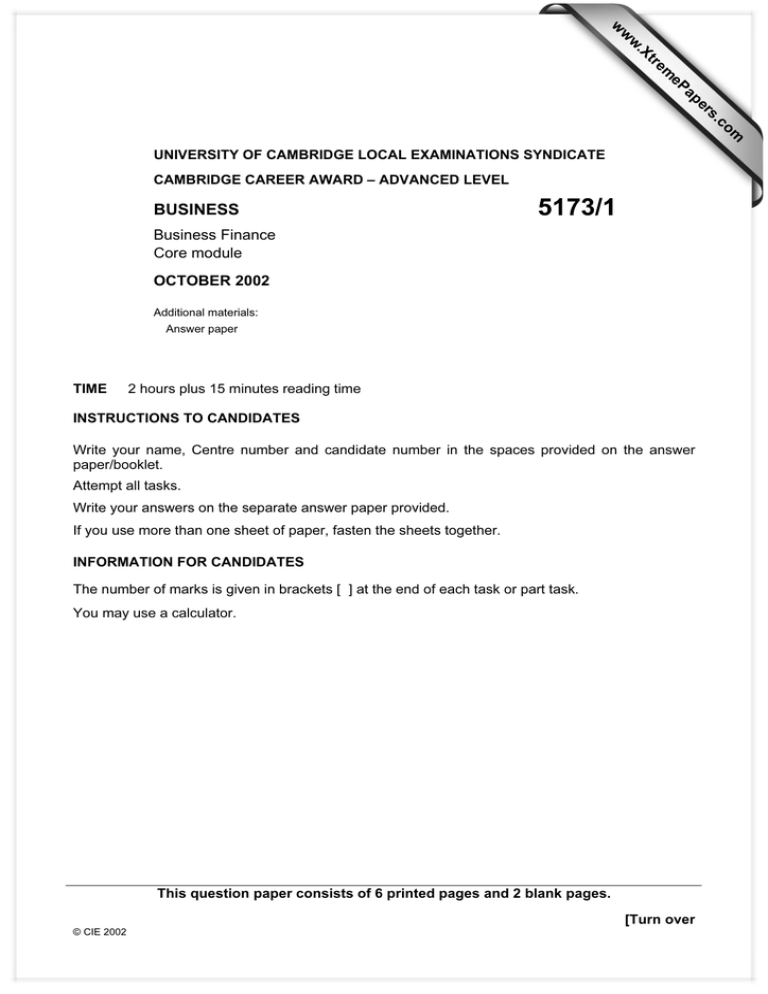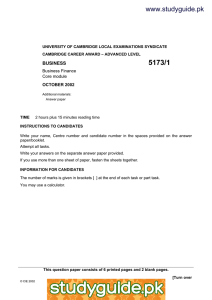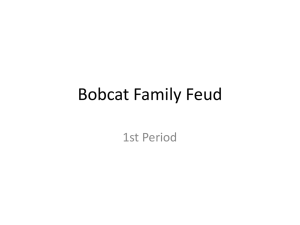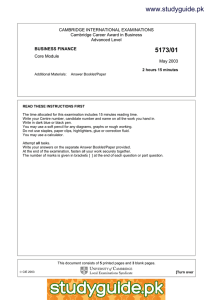BUSINESS www.XtremePapers.com Business Finance Core module
advertisement

w w ap eP m e tr .X w om .c s er UNIVERSITY OF CAMBRIDGE LOCAL EXAMINATIONS SYNDICATE CAMBRIDGE CAREER AWARD – ADVANCED LEVEL BUSINESS Business Finance Core module OCTOBER 2002 Additional materials: Answer paper TIME 2 hours plus 15 minutes reading time INSTRUCTIONS TO CANDIDATES Write your name, Centre number and candidate number in the spaces provided on the answer paper/booklet. Attempt all tasks. Write your answers on the separate answer paper provided. If you use more than one sheet of paper, fasten the sheets together. INFORMATION FOR CANDIDATES The number of marks is given in brackets [ ] at the end of each task or part task. You may use a calculator. This question paper consists of 6 printed pages and 2 blank pages. © CIE 2002 [Turn over 2 BLANK PAGE 5173/1/O/02 3 You must read the case study below and attempt ALL the tasks that follow. (The case study is purely fictitious) Case Study – BobCat Ltd BobCat Ltd has just produced its annual accounts for the sixth successive year and, once again, it has been a reasonably successful year. The company’s main business is the distribution of cleaning products such as detergents, disinfectants, bleaches, etc to hotels, restaurants and offices. The basic materials are bought in from larger multinational chemical and detergent companies and then repacked before distribution. In recent years, BobCat has widened its range to include a range of personal hygiene products called Bliss. This is marketed under an exclusive dealing agreement with a large supermarket chain. BobCat has also moved into the home cleaning market, providing carpet and fabric cleaning services via a network of local agents. The company had attempted to enter the ‘green market’ some years ago but found that its customers were unwilling to meet the premiums required. During the last year it has introduced an on-line selling system via its website, but this is causing problems and the chief accountant has recommended that it should be closed down. 5 10 Brother and sister, Bob and Catherine Russell, largely own BobCat. They hold the majority (80%) of the shares in the company, but they have allowed other family members to purchase shares as the firm has grown. They originally set up the business as a limited partnership 12 years ago. Both now take an active part in the running of the business; Bob concentrates on the financial aspects of the business whilst Catherine is more concerned with marketing and distribution. 15 Both Bob and Catherine are very keen to keep effective control over their business but they realise that if they are to continue to expand, they will probably have to consider looking for additional external sources of funding. Indeed, their chief accountant has for some time been recommending that they should consider a listing on the Alternative Investment Market (A.I.M) and/or look to involve venture capitalists. 20 Several other financial issues were raised at the recent Annual General Meeting: - The need to consider much tighter controls of the working capital of the Company. A proposal to change the method of stock valuation from the present FIFO method to a LIFO method. A proposal to adopt a cost-centred approach to allocating overhead costs. It has been agreed that the Board should meet in one month’s time after these issues have been fully investigated. 5173/1/O/02 [Turn over 25 4 Item 1 The following is the Balance Sheet of BobCat Ltd at 30 Sep 2001 and 30 June 2002 30 Sep 2001 $0000 Fixed assets at cost Less accumulated depreciation Stock Debtors Cash Creditors Corporation tax Dividends proposed Overdraft $0000 300 30 June 2002 $0000 100 200 170 220 50 440 142 50 75 267 10% Debentures issued 1 Oct 2001 Financed by: Ordinary shares of $1 each Share premium Profit & loss account $0000 670 140 530 250 295 545 161 96 125 90 472 173 373 73 603 373 50 553 100 273 373 120 80 353 553 Interest on the debentures was paid on 30 Sep 2002 Item 2 Total Fixed Overheads $667,857 Contribution to overall turnover: Core business 70% Bliss 22% Home cleaning 5% Internet sales 3% Number of employees Total = 280 Core business 220 Bliss 23 Home cleaning 17 Internet sales 20 5173/1/O/02 5 Item 3 Extracted stock figures for Bliss products during April - September 2002 Opening stock April 1 – 50000 units valued @ $10 per unit Purchases 15 April 40000 units @ $12 per unit 15 May 60000 units @ $12.5 per unit 15 June 80000 units @ $12.5 per unit 15 July 60000 units @ $13 per unit 15 Aug 70000 units @ $13 per unit 20 Aug 30000 units @ $13.5 per unit 15 Sep 60000 units @ $14 per unit Stock Issued 30 April 75000 units 30 May 55000 units 30 June 75000 units 30 July 70000 units 30 Aug 95000 units 30 Sep 70000 units 5173/1/O/02 [Turn over 6 BLANK PAGE 5173/1/O/02 7 You must attempt all of the following tasks. 1 (a) (i) Explain what is meant by 'exclusive dealing agreement'. (line 7) [2] (ii) List two financial advantages to BobCat Ltd from entering into such an agreement. [2] (b) (i) Explain what is meant by the term 'agent' as used in the case study. (line 9) [2] (ii) Explain why BobCat Ltd might prefer to employ agents to deliver its services. [2] (c) Explain what is meant by the term 'premiums' as used in the case study. (line 10) [2] (d) Identify and explain two financial problems that could arise from on-line selling. (line 11) [4] (e) Explain what is meant by the term 'Alternative Investment Market'. (line 21) [2] (f) [2] (i) Explain what is meant by the term 'working capital'. (line 24) (ii) List two methods of controlling working capital. 2 [2] [Total: 20] Bob and Catherine had originally set up in business as a limited partnership. (a) Explain what is meant by a limited partnership. [2] (b) Identify and explain one advantage and one disadvantage of operating as a limited partnership. [4] (c) Identify and explain one advantage and one disadvantage that would result from establishing the present limited company. [4] [Total: 10] 3 (a) Using the information contained in Item 1, produce a Cash Flow Statement for Bob Cat Ltd for the year ending Sep 30 2002. (b) Explain briefly why the cash balance had fallen during the years. [14] [2] [Total: 16] 4 SSAP2 ‘Disclosure of Accounting Policies’ defines four fundamental accounting concepts. State and define any three of these concepts, and explain and give examples of their impact on the published accounts of a limited company. [12] 5 (a) Using the information contained in Item 2, calculate the allocation of fixed overheads, employing both the contribution to turnover and number of employees as cost centres. [8] (b) Give a reasoned recommendation as to which of these cost centres would be more appropriate for BobCat Ltd. [4] [Total: 12] 5173/1/O/02 [Turn over 8 6 (a) (i) Explain the difference between a bonus issue of shares and a rights issue of shares. [6] (ii) Explain the circumstances in which a share premium account arises. [2] (b) Compare and contrast the risks of using shares with the risks of using debentures as alternative ways of raising additional finance. [6] [Total: 14] 7 Using the information contained in Item 3, calculate the closing stock figures and the values of stock issued by employing both the FIFO and LIFO methods of stock valuation. [16] 5173/1/O/02



